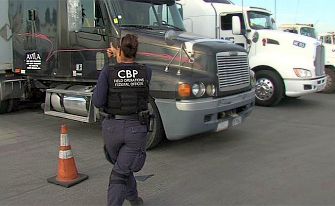 |
| US Customs and Border Protection Commissioner R. Gil Kerlikowske, with Aristoteles Nunez Sanchez, chief of Mexico’s Tax Administration Service at the signing of an agreement on trusted trader programs. |
San Ysidro, California — Backed by trucking groups, customs brokers, and others involved in cross-border trade, the United States and Mexico have announced an agreement aimed at streamlining the passage of goods across the border in both directions.
US Customs and Border Protection Commissioner R. Gil Kerlikowske joined Aristoteles Núñez Sánchez, chief of Mexico’s Tax Administration Service, in signing an accord that mutually recognizes each other’s "trusted trader" programs last Friday.
At a small ceremony at the San Ysidro Port of Entry, Kerklikowske called it "a significant achievement for the trade relationship between the United States and Mexico." The arrangement is similar to one currently in place between the United States and Canada, and "will ultimately result in a more efficient and secure supply chain between our two countries," Kerlikowske said.
Members of trusted trader programs who voluntarily submit to an extensive verification process are able move goods across the US-Mexico border faster than those who are not enrolled. The agreement potentially benefits anyone involved in cross-border trade in both countries, from shippers to manufacturers to brokers. Eventually, it could lead to a single application for both the US and Mexican programs.
 |
On the US side, the Customs-Trade Partnership Against Terrorism, or C-TPAT, since November 2001 has enrolled close to 11,000 members of the trade community. Mexico launched its program in January 2012, naming it the New Scheme of Certified Companies, or by its Spanish-language acronym, NEEC; it currently has 392 participants.
The two governments will continue to operate separate programs, "but if you’re vetted by Mexican authorities, it will be very helpful if you are going to apply for C-TPAT, and vice versa. What this shows is mutual recognition of standards," Kerlikowske said. "If you now have NEEC, you will be given bonus points when you sign up for C-TPAT, because you’ve already been vetted, and the same will hold true for vice-versa."
Witnessing the signing were members of the trade community on both sides of the border.
"If we are able to implement the program the way it’s supposed to work, everybody benefits with the reduction in cost, the reduction in wait times," said Martin Rojas, vice president for security and operations at the American Trucking Associations.
Also in the audience was Eduardo Acosta, a customs broker and vice president of San Diego's Otay Mesa Chamber of Commerce. . "The key to all of this is making sure there is a direct benefit, because if the benefit is promised and not delivered, then people will stop joining," he asserted.
Jorge Arizona, a member of the national executive council of the Mexican trucking chamber, Canacar, said agreements such as these will help "clear the enormous congestion at the border crossings. These are the same problems that we see everywhere, from Matamoros to Tijuana."
US trade with Mexico in goods and services totaled $536 billion in 2012 — with $243 billion in exports and $293 billion in imports, according to the Office of the US Trade Representative. By volume, the second busiest US commercial port of entry with Mexico is Otay Mesa, which last fiscal year processed 780,000 truck crossings that carried $23 billion in merchandise into the United States, according to US Customs and Border Protection.
Original Story
No comments:
Post a Comment